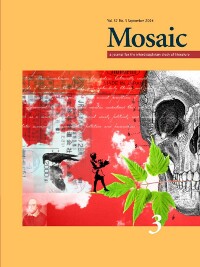Issue 37.3
Overview

General Issue
Published: September 2004
View the issue introduction or see the issue summary and contents below.
11 essays, totalling 192 pages
$15.00 CAD
This general issue of Mosaic contains twelve essays that explore and dramatize loss and the ego’s attempts at recovery and control; the subject severed, if not split; the subject and object in opposition; retrieval and repetition; cries in representation; juxtapositions (of Paul Auster and Alfred Hitchcock, Franz Kafka and Emmanuel Levinas, evolution and extinction, poetry and theory, sculpture and poetry) and collaborations; folklore in fabulist fiction; and fairy tales.
“Loving Ourselves Best of All”: Ecocriticism and the Adapted MindNANCY EASTERLIN This essay argues that ecocriticism requires a theoretical foundation to establish its coherence as a literary sub-discipline, a foundation that should be sought not only in a general understanding of evolutionary theory but especially in a knowledge of evolutionary and related areas of psychology. | |
Franz Kafka’s “The Burrow” as Model of Ipseity in Levinasian TheoryLAURA STAHMAN Taking the interpretive cues from the philosophical insights of Emmanuel Levinas, this essay argues that Franz Kafka’s “The Burrow” may be read (post-Heidegger) as a critique of the fundamental ontology that posits “being-toward-death” and absolute understanding of being as the primary mode and concern of human existence. | |
A Feminist Reading of Soucouyants in Nalo Hopkinson’s Brown Girl in the Ring and Skin FolkGISELLE LIZA ANATOL Using an interdisciplinary approach, this essay explores Nalo Hopkinson’s use of Caribbean folklore in her fabulist fiction, particularly her representations of the soucouyant and La Diablesse: creatures that have conventionally been employed in Caribbean popular culture to condemn female power and socialize women according to patriarchal dictates. | |
Bucking a Trend: Oates’s “The Buck” and Drabble’s The Witch of ExmoorLISA FIANDER Joyce Carol Oates’s story “The Buck” and Margaret Drabble’s novel The Witch of Exmoor might be read as reflections of the Grimms’ fairy tale “Brother and Sister,” in which a young woman cares for her brother after he is transformed into a deer. Oates and Drabble challenge the common perception of fairy tales as childish, sexist, and escapist. | |
Classical Tourism in Debora Greger’s PoetryMARSHA BRYANT and MARY ANN EAVERLY This interdisciplinary, collaborative essay assesses the figuration of ancient Roman statues, temples, and excavated cities in poems by Debora Greger, arguing for an expanded sense of women poets’ relationships to the Classical tradition. “Classical tourism” proves more accessible and flexible than the revisionist mythmaking that has drawn more critical attention. | |
From Punishment to Possibility: Re-Imagining Hitchcockian Paradigms in The New York TrilogyCAMERON GOLDEN This essay examines intertextual links between Paul Auster, a fiction writer with a filmmaker’s sensibility, and Alfred Hitchcock, suggesting that Auster has re-narrated Hitchcock’s work to allow his detectives the postmodern (and American) possibility of reinvention. | |
Durassic Park: Evolution and Extinction in the Work of Marguerite DurasJON WAGNER and LYNNE GOODHART Is the work of Marguerite Duras a retreat from reality and truth or an “erasure in favor of the all”? This essay takes an evolutionary perspective on the self informed by transpersonal psychology, offering a critique of common themes in Duras scholarship, particularly indeterminacy. | |
“Pursuit of Unsayables”: Repetition in Kristeva’s Black Sun and Strand’s “Two de Chiricos”MALCOLM WOODLAND Both Julia Kristeva and Mark Strand gesture toward verbal repetition’s ambivalent relationship to loss and ineffability: This essay suggests, however, that Kristeva’s Black Sun tries to subsume repetition’s ambivalence within a therapeutic teleology, whereas Strand’s villanelles refuse to limit its affective complexity. | |
Taking it Back: Crises of Currency in David Mamet’s American BuffaloWILLIAM LITTLE Buffaloed by the currencies powering America’s modern exchange economy, the men in David Mamet’s American Buffalo pursue success by plotting a heist and, paradoxically, by plotting to remove money, language, and bodies from circulation. This essay examines how the paradox dramatizes a doubly blind American rage to achieve material success and to escape materiality altogether. | |
Is the Butler Home? Narrative and the Split Subject in The Remains of the DayMOLLY WESTERMAN This essay reads the narrative structures of Kazuo Ishiguro’s The Remains of the Day using postcolonial and psychoanalytic theory. It argues that ambivalence and inconsistencies in the narrator’s language do not create unreliability but tell us what the narrator does not know: how his experience as a split subject is constituted, and how it constitutes him. | |
Aesthetic Consolation and the Genius of the Place in Stoppard’s ArcadiaALISON E. WHEATLEY As a metaphor in action, Tom Stoppard’s Arcadia thematically and dramatically superimposes ideals in landscape and other human endeavour onto the losses in those realms. Even though the “genius of the place,” the perceived essence of the human or the natural, is unrecoverable, human creation can provide aesthetic consolation. |